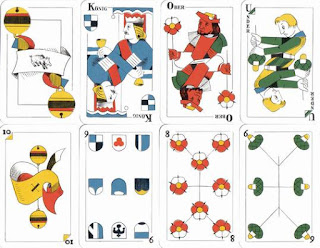Many different types of deck have been
used in Europe since the introduction of playing cards around the 14th
century, and several types of deck are still used in various regions for
various games. Almost all of them have in common that there are exactly
four suits, and numbers or other symbols indicate which cards within a
suit are "better", "higher" or "more valuable" than others, whereas
there is no order between the suits unless defined in the rules of a
specific game. There is exactly one card of any given rank in any given
suit. The differences between European decks are mostly in the number of
cards in each suit; for example,
- 13 in the commonly-known French deck,
- 14 in the French Tarot game,
- 10 in Spain,
- 10 in Italy and in some games in Spain,
- 9 in Switzerland for the Jass,
- 8 in some games in Germany and Austria, e.g. Skat
- 8 for Belote in France,
- 5 in Hungarian Illustrated Tarock,
and in the inclusion or exclusion of an extra series of (usually) 21 numbered
cards known as tarocks or trumps, sometimes considered as a fifth suit,
but more properly regarded as a group of special suitless cards, to
form what is known as a Tarot deck.
SPAIN
ITALY
GERMANY
SWITZERLAND
My intention in CelticJourney was to create a special deck of playing cards that would have the essence of Ireland, its culture and its art.
The suits of this deck are based on artifacts of the Irish culture:
-Ardagh Chalice: discovered in September 1865 in a ring fort at Reerasta, Ardagh, Limerick.
-Tara Broach: a Celtic broach of about 700 AD found in Co Meath.-Harp: for centuries the
harp has been a beloved emblem of Ireland.
-Celtic helmet: relating to the Celts, whose protective armor included an iron helmet.Jacks, Queens and Kings in each of the suits relates to a figure from the Irish Mythology, having the whole deck 12 different figures.
The four provinces
of Ireland, Connaught, Leinster, Munster and Ulster are represented in
the deck, as each of the King figure shows a shield of one of the
provinces.
The detailed art-work and the vibrant colours used in my designs make the onlookers stop and have a closer look, to be taken then into a journey.It is then, that from distant past, come tales of Gods, giants and heroes.
The price of each deck is E6.99.Postage within Ireland is E2. Postage to rest of the world is E3.80 with postage
If you would like to see other countries deck of cards, have a look at this website: http://www.wopc.co.uk/
My Irish Mythology cards are featured in their site too:








































